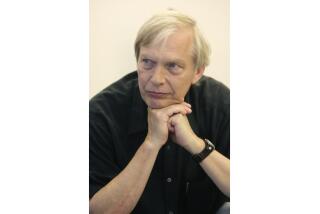Robert M. Batscha, 58; Led Museum of TV & Radio
- Share via
Robert M. Batscha, who spent more than two decades guiding the New York-based Museum of Television & Radio and oversaw the establishment of a sister venue in Beverly Hills, died Friday in New York City from complications related to cancer. He was 58.
Batscha’s death -- which occurred suddenly enough to surprise many associated with the nonprofit museum -- followed surgery to remove his spleen a few months ago. He was recuperating from that surgery when his condition took a recent turn for the worse, said museum Chairman Frank A. Bennack Jr.
Bennack, who retired last year from his position as chief executive of Hearst Corp., said he would take a more active role at the museum until a successor can be found, adding that a strong senior staff was already in place.
Originally an academic, Batscha was named president of what was then known as the Museum of Broadcasting in 1981. He was chosen by William S. Paley, the chairman and founder of CBS, who had created the institution to celebrate and preserve broadcasting six years earlier.
Under Batscha’s stewardship, the museum dramatically expanded its TV and radio collection to more than 120,000 programs, launched a series of occasional TV specials featuring classic shows, and introduced an annual Los Angeles-based television festival honoring past and current productions.
“It was Bill Paley’s seed, but Bob made it grow.... He got everyone to do what he needed and wanted, because he had such charm and such enthusiasm,” actress Marlo Thomas, a longtime museum trustee, said Monday.
Always nattily attired, Batscha was a smooth and adept fund-raiser. Raising money became necessary to finance the Beverly Hills museum that opened in 1996 and duplicated the original’s programming roster.
The museum, at Santa Monica Boulevard and Beverly Drive, holds an annual black-tie gala in Beverly Hills, which, in its early years, involved closing the adjacent street for a $1,000-a-plate dinner that prompted satirist Harry Shearer to quip: “Anything that puts black AstroTurf on Beverly Drive is OK with me.”
Despite questions about a lack of traffic at the West Coast location, Bennack said that the venue is “making very good progress” and that signs for it are healthy.
In a broader sense, Bennack credited Batscha with establishing the museum on both coasts as a forum for industry leaders.
“He made this a place where people who would ordinarily be intense competitors came together to talk about the bigger issues,” Bennack said.
A native of Rochester, N.Y., Batscha was raised in New York City and graduated from Queens College. At Columbia University, he earned a master’s degree in international affairs in 1969 and a doctorate in political science in 1972.
For three years, he served as a senior consultant at the Organization of Economic Cooperation and Development in Paris and was president of the Population Resource Center before Paley, who died in 1990, tapped him to run the museum.
Batscha remained active in academic circles, serving as chairman of Columbia University’s Faculty Seminar in Communication and founding the Center for Communication, a nonprofit that places students and faculty in contact with communications professionals.
He is survived by his son, Eric. A private funeral service is scheduled for today in Manhattan, and a memorial service is being planned.
More to Read
The biggest entertainment stories
Get our big stories about Hollywood, film, television, music, arts, culture and more right in your inbox as soon as they publish.
You may occasionally receive promotional content from the Los Angeles Times.










